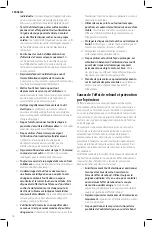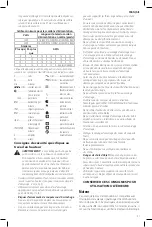
English
6
•
An extension cord must have adequate wire size
(AWG or American Wire Gauge) for safety.
The smaller
the gauge number of the wire, the greater the capacity
of the cable, that is, 16 gauge has more capacity than 18
gauge. An undersized cord will cause a drop in line voltage
resulting in loss of power and overheating. When using
more than one extension to make up the total length,
be sure each individual extension contains at least the
minimum wire size. The following table shows the correct
size to use depending on cord length and nameplate
ampere rating. If in doubt, use the next heavier gauge. The
lower the gauge number, the heavier the cord.
Minimum gauge for Cord sets
Volts
Total length of Cord in Feet
(meters)
120 V
25 (7.6)
50 (15.2) 100 (30.5) 150 (45.7)
240 V
50 (15.2) 100 (30.5) 200 (61.0) 300 (91.4)
Ampere Rating
American Wire gauge
More
Than
not
More
Than
0
6
18
16
16
14
6
10
18
16
14
12
10
12
16
16
14
12
12
16
14
12
Not Recommended
The label on your tool may include the following symbols. The
symbols and their definitions are as follows:
V ......................... volts
Hz .......................hertz
min .....................minutes
or DC ......direct current
...................... Class I Construction
(grounded)
…/min ..............per minute
BPM ....................beats per minute
IPM .....................impacts per minute
RPM .................... revolutions per
minute
sfpm ................... surface feet per
minute
SPM ....................strokes per minute
A .........................amperes
W ........................watts
or AC ...........alternating current
or AC/DC .... alternating or
direct current
...................... Class II
Construction
(double insulated)
no .......................no load speed
n .........................rated speed
......................earthing terminal
.....................safety alert symbol
.....................visible radiation
..................... wear respiratory
protection
..................... wear eye
protection
..................... wear hearing
protection
..................... read all
documentation
Safety Warnings Specific for Use At
Height
WARNING:
If the tool is dropped for any reason the
lanyard connection must be inspected and properly
serviced prior to re-use. The lanyard connection is
designed to stretch to absorb the shock of a drop.
Any permanent stretch to the connection exposing
the red marked internal coils indicates it has been
compromised and must be serviced prior to reuse.
• Always keep the tool and accessories tethered when
working "at height". [Maximum lanyard length: 6.5 ft
(2m)]
• Use only with lanyards appropriate for this tool type and
rated for at least 12.0 lbs (5.43 Kg).
•
Crush, cut or entanglement hazard.
Do not use near
moving parts, mechanisms or running machinery.
• Do not anchor the tool lanyard to anything on your body.
Anchor to a rigid structure that can withstand the forces
of a dropped tool.
• Make sure the lanyard is properly secure at each end prior
to use.
• Inspect tool and lanyard before each use for damage and
proper function (including fabric and stitching). Do not
use if damaged or not functioning properly.
• Do not alter the lanyard connection or use in a manner
other than as instructed in this manual.
• Only attach tool to a lanyard with a locking carabiner. Do
not attach by looping or knotting the lanyard. Do not use
rope or cord.
• Electrical shock hazard. Be sure power is off when working
in high voltage areas. Some lanyards are conductive.
• Dropped tools will swing on the lanyard, which could
cause injury or loss of balance.
• Do not carry the tool by attachment device or the lanyard.
• Do not attach more than one tool to each lanyard.
• Only use appropriate
D
e
WALT
brand attachment point.
NEVER modify tools to create attachment points.
• Only transfer the tool between hands while properly
balanced in a stable orientation.
• Do not attach lanyards to tool in a way that keeps guards,
switches or lock-offs from operating properly.
• Avoid getting tangled in the lanyard.
• Keep lanyard away from the cutting area of the tool.
• Do not use lanyards or attachment devices to get
additional leverage from the tool.
• Do not use for personal fall protection.
•
Falling object hazard!
Only change accessories and
attachments where a dropped object won't cause a
hazard below you. Consult your AHJ or site supervisor for
procedures for working at height.
• Use multi-action and screw gate type carabiners. Do not
use single action spring clip carabiners.
SAVE THESE INSTRUCTIONS FOR
FUTURE USE
Motor
Be sure your power supply agrees with the nameplate
marking. Voltage decrease of more than 10% will cause loss
of power and overheating.
D
e
WALT
tools are factory tested;
if this tool does not operate, check power supply.
COMPONENTS (FIG. A)
WARNING:
Never modify the power tool or any part
of it. Damage or personal injury could result.
Refer to Figure A at the beginning of this manual for a
complete list of components.









































